Are you an adventure-seeker looking for the best hiking backpack for women?
Look no further!
Choosing the wrong backpack can turn your adventure into a nightmare—imagine struggling with sore shoulders, an aching back, or not having enough space for your essentials right when you need them most.
I’ve been there, and it’s no fun.
But the right hiking backpack? Well, that’s a game-changer. A well-designed backpack will make your hike comfortable and stress-free. It will distribute weight evenly, provide quick access to your essentials, and fit snugly without weighing you down, allowing you to focus on enjoying the beauty of the trail.
In this ultimate guide, I’ll explore the top hiking backpacks on the market for women, what makes them special, and how to choose the perfect one for your needs.
| CATEGORY | WINNER | VISUAL | FIND HERE |
|---|---|---|---|
| Best Overall | Osprey Tempest 20 |  | |
| Best Ultralight Daypack | CamelBak Sequoia 24 |  | |
| Best Hydration Pack | Gregory Jade 28 |  | |
| Best For Small Hikes and Everyday Use | The North Face Borealis |  | |
| Best Unisex | Patagonia Refugio Day Pack |  | |
| Best Budget | Maelstrom Hiking Backpack |  |
Features to Look for in Women’s Hiking Backpacks
Before we get into specific recommendations, let’s talk about what you should look for in a good hiking backpack.
As a beginner or someone who enjoys easier treks, having a well-suited pack can make all the difference between a wonderful day on the trail and a day filled with discomfort.
Here are the key features to keep in mind:
- Comfortable Fit: Look for a pack designed specifically for women. These bags usually have contoured straps and shorter torso lengths to fit your body better. A snug, comfortable fit means no rubbing or awkward pressure points.
- Weight: A lightweight backpack is your best friend, especially on long hikes. The less weight you start with, the more energy you’ll have to enjoy your adventure.
- Capacity: For day hikes, you’ll want something between 15-30 liters—just enough space for essentials like water, snacks, and a first aid kit, without being bulky.
- Ventilation: A well-ventilated back panel will help keep you cool, even on warmer days. No one likes the feeling of a sweaty back, and good ventilation makes a huge difference in staying comfortable.
- Pockets and Organization: It’s all about keeping your items organized! Look for easy-access pockets for things like snacks, maps, or your phone, and side pockets for water bottles or a sleeping bag compartment.
- Hydration Compatibility: A backpack with a built-in hydration reservoir sleeve can be a game-changer. It makes staying hydrated a breeze since you won’t have to stop and dig out a water bottle.
- Adjustable Straps: Adjustable, hip, chest, and shoulder straps let you customize the fit to your body. A properly adjusted pack helps distribute the load evenly, reducing shoulder strain and making your hike more comfortable.
- Durability: The material matters. A durable, tear-resistant fabric means you won’t have to worry about your backpack giving out on rocky trails or in unpredictable weather.
Choosing a backpack with the right features will make sure you have everything you need, exactly when you need it, without unnecessary hassle or discomfort.
Does the Sex Really Matter?
You might be wondering, “Does it really matter if the backpack is specifically for women?” And honestly, it’s a fair question.
Women’s hiking backpacks are more than just a marketing gimmick. They’re designed with features that make hiking more comfortable for women’s body shapes. For example, women’s packs often have a shorter torso length, narrower shoulder straps, and hip belts that sit differently, all to match our anatomy better. These little adjustments can make a world of difference in comfort, especially during longer hikes.
Of course, comfort is subjective—some women find that unisex or men’s packs fit just fine. It really depends on your body shape and personal preferences. I always recommend trying on a few packs in-store, with some weight inside, to see what feels best for you. Remember, the goal is to feel like your backpack is an extension of your body, not a burden to carry.
So yes, while it does matter in terms of comfort, the ultimate choice comes down to finding what works best for your body and hiking style.
What Is the Best Hiking Backpack for Women?
Now that you know all about what features to look out for in your next hiking companion, let’s get into the good stuff.
Here are my 7 top picks for hiking backpacks for women.
1. Osprey Tempest 20
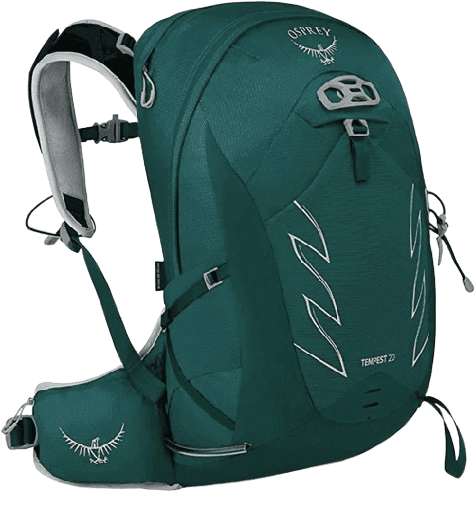
Best Overall
The Osprey Tempest 20 is my favorite hiking backpack for easier treks and for women in general.
This bag is designed specifically for women, and it shows—from the contoured hip belt to the narrower shoulder straps- that it offers a snug and comfortable fit for those long day hikes.
I love how versatile it is, with features like the Stow-On-The-Go™ trekking pole attachment and LidLock™ helmet attachment, making it great not just for hiking but also for other outdoor adventures.
Plus, the AirScape™ back panel ensures that I stay cool even on warm days, which is a huge bonus!
Key Benefits:
- Women-specific fit: Narrower shoulder straps and contoured hip belt for added comfort.
- AirScape™ back panel: Excellent ventilation to keep you cool during your hike.
- Adjustable torso length: Customizable fit for all-day comfort.
- Stow-On-The-Go™ trekking pole attachment: Easily stow your hiking poles on the move.
- LidLock™ helmet attachment: Convenient for outdoor activities involving a helmet.
- Integrated rain cover: Keeps your gear dry in wet conditions.
Pros:
- Lightweight and comfortable
- Great ventilation
- External pockets
- Versatile attachments for hiking poles and helmet
- Women-specific fit
Cons:
- Limited capacity for longer hikes
- Can be a bit pricey for beginners
2. Deuter Speed Lite 22 SL
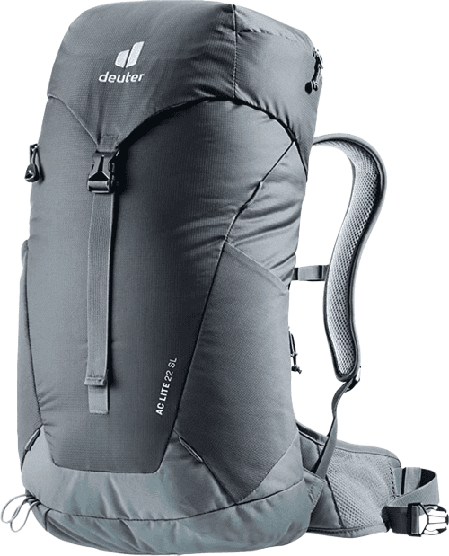
The Deuter Speed Lite 22 SL is perfect for those of us who want to keep things light without sacrificing comfort.
I love how this backpack combines an ultra-lightweight design with practical features, making it ideal for a day hike where you want to carry just enough.
The ergonomic S-shaped shoulder straps and contoured hip belt are designed specifically for women, providing a secure and comfortable fit, even on longer trails.
Plus, the dual access hydration compartment and daisy chain attachment points make it super versatile for a variety of adventures.
Key Benefits:
- Women-specific fit: Ergonomic S-shaped shoulder straps and contoured hip belt for a more comfortable fit.
- Lightweight design: Weighs only 1.5 lbs, reducing the load you have to carry.
- Breathable foam back panel: Keeps your back cool during hot hikes.
- 3D-AirMesh: Enhances breathability and reduces friction on the shoulder straps and hip belt.
- Dual access hydration compartment: Easily access your hydration bladder from the top or side of the pack.
- Daisy chain attachment points: Attach extra gear easily using the looped webbing.
Pros:
- Extremely lightweight
- Great ventilation with breathable back panel and straps
- Dual access hydration compartment for convenience
- Women-specific ergonomic fit
Cons:
- Limited storage for bulkier gear
- Lacks an integrated rain cover
3. Gregory Jade 28
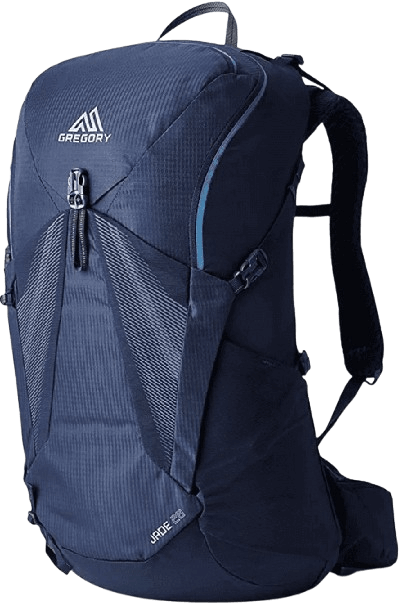
Best Hydration Pack
The Gregory Jade 28 is a fantastic choice if you’re looking for a spacious, comfortable hydration pack that can handle longer day hikes.
I love how the FreeFloat™ suspension system adapts to your body, providing great ventilation and making it feel like the comfortable pack is moving with you, rather than against you.
It’s tailored specifically for women, with an adjustable shoulder harness and contoured hip belt to ensure a perfect fit.
Plus, the dedicated hydration compartment keeps your water separate from your gear, making it easy to stay hydrated without the hassle.
Key Benefits:
- Women-specific fit: An adjustable shoulder harness and contoured hip belt are needed for a tailored, comfortable fit.
- FreeFloat™ suspension system: Excellent ventilation and load distribution for all-day comfort.
- Dedicated hydration compartment: Keeps your water reservoir separate for seamless access and convenience.
- QuickStow™ sunglass storage: Securely store your sunglasses on the shoulder harness for quick access.
- Trekking pole attachment: Conveniently attach trekking poles with bungee loops and clips.
- Front U-zip access: Easily access your gear through the large, U-shaped front zipper.
Pros:
- Great ventilation with FreeFloat™ suspension system
- Adjustable torso for a customized fit
- Spacious with easy front access
- Women-specific fit and supportive hip belt
Cons:
- A bit heavier compared to smaller packs
- Higher price point for beginners
4. The North Face Borealis 25L
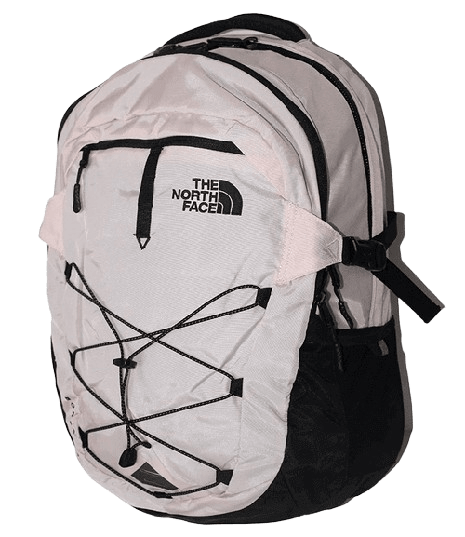
Best For Small Hikes and Everyday Use
I’ve always been a fan of The North Face, and the Borealis 25L is a great example of why.
Their designs are modern, cool, and versatile—perfect for someone like me who wants gear that works just as well for a short hike as it does for a day in the city.
The women’s-specific FlexVent™ suspension system provides a comfortable fit, with custom-molded shoulder straps and a padded back panel that keeps you cool.
I love that it has a dedicated laptop compartment, which makes it great for those quick day hikes or when you need a pack that can transition seamlessly from trail to town. I’ve personally used it for light day hikes, and it worked perfectly!
Key Benefits:
- Women-specific fit: FlexVent™ suspension system with custom injection-molded shoulder straps for a secure and comfortable carry.
- Dedicated laptop compartment: Safely store a laptop or tablet, ideal for both hiking and daily use.
- Large main compartment: Ample space for clothing and gear, perfect for small trips.
- Front organizational panel: Keep smaller items like snacks or a phone organized and within easy reach.
- External bungee system: Attach extra gear quickly using the front bungee cords for added versatility.
Pros:
- Modern and versatile design
- Comfortable suspension system endorsed by the ACA
- Dedicated laptop compartment for everyday use
- Spacious with easy-access organization
Cons:
- Slightly bulky for minimalists
- Not ideal for longer or gear-heavy hikes
5. Patagonia Refugio Day Pack
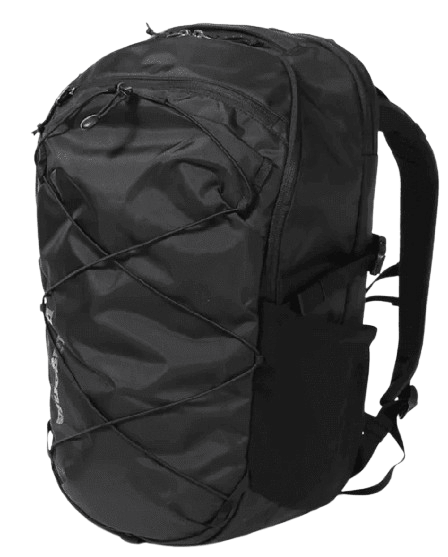
Best Unisex
The Patagonia Refugio Day Pack 30L is a fantastic unisex option, offering both functionality and a commitment to sustainability.
I love Patagonia not just for its durable, high-quality gear but also for its dedication to ethical production and environmental responsibility. This pack is made from 100% recycled polyester, with a PFC/PFAS-free water-repellent coating, making it a perfect choice for those who want to minimize their impact on the planet while enjoying the great outdoors.
It’s also the largest pack in their everyday line, making it ideal for carrying heavier loads, whether you’re hitting the trail or bringing your gear to the gym.
Key Benefits:
- Sustainably made: Constructed from 100% recycled polyester, with a Fair Trade Certified™ production process.
- Versatile and spacious: 30L capacity with multiple compartments, perfect for day hikes or carrying gym gear.
- Padded laptop sleeve: Removable padded sleeve for up to 15″ laptops, ideal for work and play.
- Hydration system ready: Breathable back insert and loop to secure your hydration system, making it trail-ready.
- Functional organization: Removable organizer for tech devices, plus pockets for quick access to frequently used items.
- Bike light clip: A practical clip at the bottom to secure a bike light for commuting.
Pros:
- Sustainable materials and ethical production
- Large capacity with lots of organization options
- Removable laptop sleeve for versatility
- Suitable for both trail use and daily commutes
Cons:
- Slightly heavier than smaller packs
- Larger size may feel bulky for shorter trips
- Not specifically for women
6. CamelBak Sequoia 24
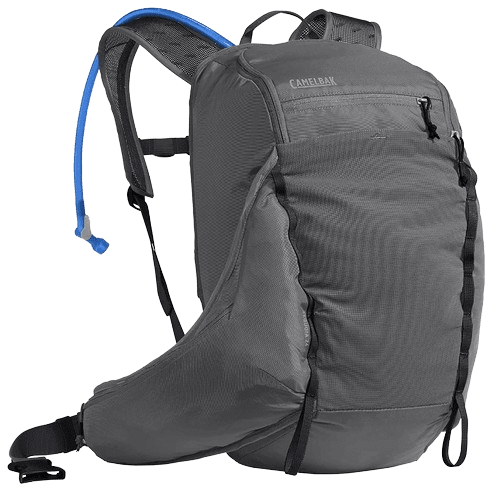
Best Ultralight Daypack
The CamelBak Sequoia 24 is a great hydration-focused and light daypack for women.
Designed with a women-specific fit, it has a narrower shoulder harness and contoured hip belt, making it comfortable for all-day hikes. What I love most about this pack is the 3L Crux™ hydration reservoir—it keeps me hydrated without having to stop, which is a lifesaver on warmer days.
The NV™ back panel and Air Support technology keep me cool, while the hip belt pockets make it easy to grab essentials like snacks or my phone without having to take off the pack.
If you’re someone who prioritizes hydration and comfort, this lightweight daypack is a perfect choice.
Key Benefits:
- Women-specific fit: Narrower shoulder harness and contoured hip belt for a comfortable, secure fit.
- 3L Crux™ hydration reservoir: Keeps you hydrated easily with a large 3-liter capacity.
- NV™ back panel: Excellent ventilation to keep you cool on the trail.
- Large main compartment: Spacious enough for storing gear and clothing.
- Stretch front pocket: Quickly stash extra items or layers for easy access.
- Zippered hip belt pockets: Keep essentials like snacks or a phone within reach.
Pros:
- Excellent hydration system included
- Lightweight with women-specific fit
- Great ventilation with NV™ back panel
- Convenient hip belt pockets for easy access
Cons:
- Limited capacity for longer hikes
- Slightly bulky with a full hydration reservoir
7. Maelstrom Hiking Backpack
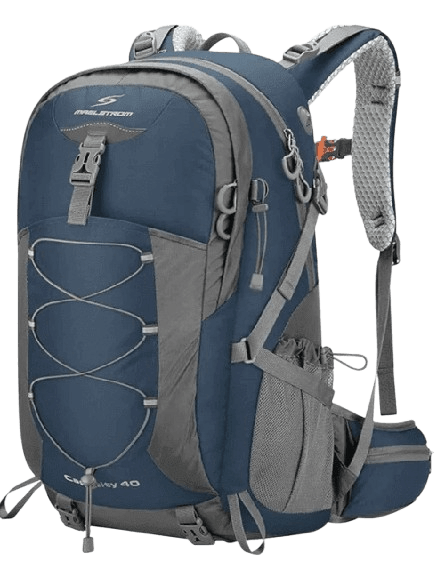
Best Budget
If you’re looking for a solid budget-friendly backpack, the Maelstrom 40L is an excellent choice, especially if you’re just starting out or prefer smaller trails.
It’s lightweight, water-resistant, and even comes with a rain cover—features you don’t often find at this price point. Made with high-quality rip-stop 210d nylon fabric, it’s resistant to tears and scratches, making it a great entry-level pack.
It offers plenty of space with multiple compartments and handy pockets, while the ergonomic design keeps it comfortable during those longer hikes.
Sure, it’s not as durable as some pricier options, but it’s perfect if you’re not ready to make a big investment just yet.
Key Benefits:
- High-quality rip-stop material: Water-resistant, tear-resistant, and wear-resistant, with an included rain cover for extra protection.
- Ergonomic design: Padded, breathable shoulder straps and back panel reduce fatigue and add comfort.
- Large capacity: 40L capacity with multiple pockets for easy organization—perfect for camping, hiking, or travel.
- Unique features: Safety reflective signs, trekking pole holders, a headphone hole, and a water bladder compartment for added convenience.
- Budget-friendly: A great option for beginners or casual hikers.
Pros:
- Affordable
- Lightweight
- Water-resistant with included rain cover
- Large capacity with lots of pockets for storage
- Ergonomic design with padded shoulder straps
Cons:
- Zippers may catch and feel less sturdy
- Elastic cords aren’t well-sewn
- Less durable compared to higher-end options
- Not specifically designed for women
- Fewer pockets
Buying Guide: How I Conducted My Research
To help you find the perfect hiking backpack, I focused on a few key areas:
Durability and Price: High-quality materials and reinforced construction were a must, while also balancing options for different budgets. A good backpack is an investment that pays off over time.
Comfort and Fit: I chose daypacks specifically designed for women, with features like narrower shoulder straps, contoured hip belts, and ventilated back panels for a comfortable fit.
Capacity: I selected packs based on different hiking needs—20-25L for short hikes and 25-30L for longer treks. Each pack has multiple pockets for easy organization for things like a sleeping bag or a hydration pack.
Weight: Lightweight packs were prioritized to minimize strain, while still considering durability for the intended conditions.
Hydration Compatibility: I only recommended packs with hydration compartments or sleeves, ensuring quick access to water, plus side pockets for bottles.
Additional Features: I looked for useful extras like trekking pole attachments, rain covers, and gear loops for added versatility.
How to Properly Care For Your Backpack After a Hike

Taking care of your backpack after a hike is essential to keep it in great shape for future adventures. Here are a few simple steps to help maintain your backpack:
- Empty and Shake Out: Remove all items, including crumbs and dirt, by giving your pack a good shake.
- Clean with Mild Soap: Use a soft cloth or sponge with mild soap and water to wipe down the exterior. Avoid harsh chemicals that could damage the fabric.
- Spot Clean Stains: Gently scrub any stains or muddy areas with a soft brush.
- Air Dry: Let your backpack air dry in a cool, shaded area. Avoid direct sunlight, as it can weaken the material over time.
- Store Properly: Store your backpack in a dry place, ensuring it’s not compressed, to keep its shape and functionality intact.
- Check Buckles and Zippers: Inspect all buckles, straps, and zippers for damage. Fix or replace any broken parts before your next hike.
Best Brands for a Hiking Backpack for Women
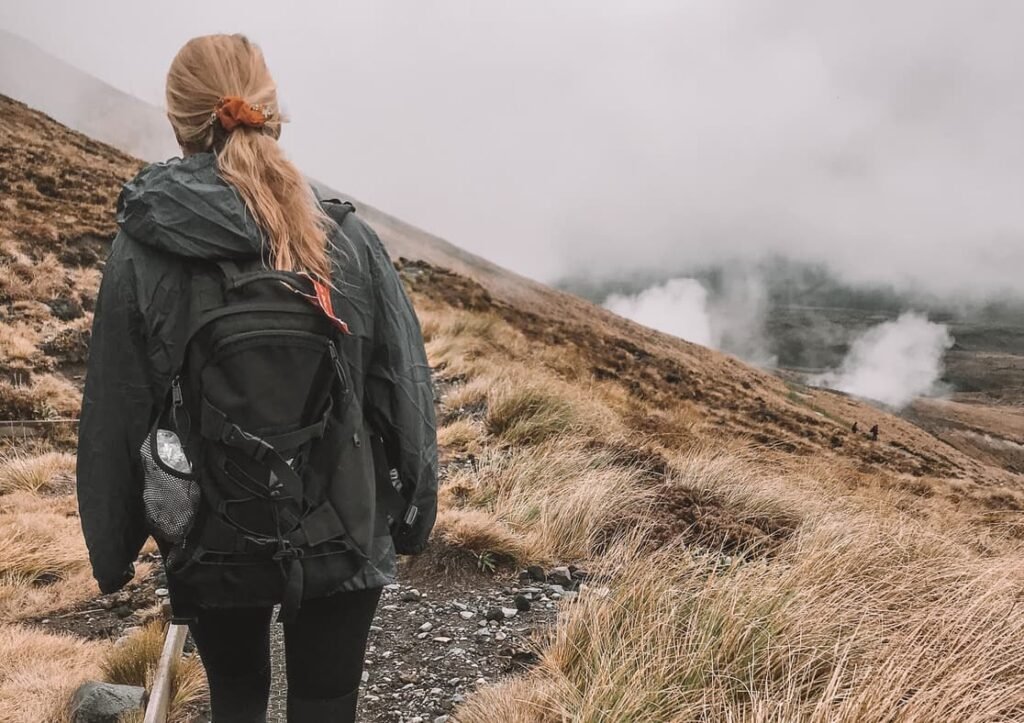
Some brands stand out for their exceptional quality, durability, and functionality—especially when it comes to women’s specific packs.
Here are the best brands for women’s hiking backpacks and what makes them particularly outstanding:
- Osprey: Osprey is well-respected for its range of high-quality backpacks and daypacks. They focus on ergonomic, innovative designs that prioritize comfort and functionality. Their daypacks have custom-fit suspension systems, ventilated back panels, and well-organized compartments—perfect for a comfortable hiking experience.
- Deuter: Deuter is a German brand with over a century of experience, known for reliable and comfortable backpacks. Their daypacks are made with robust materials that last and feature great ventilation systems, like the Aircomfort back panel, to reduce perspiration during hikes.
- The North Face: The North Face is globally recognized for rugged, durable daypacks that can handle harsh conditions. Their packs come with excellent organization and storage options, making them a popular choice for hikers and adventurers.
- Patagonia: Patagonia is known for its focus on sustainability and producing high-quality outdoor gear. Their daypacks are made from recycled materials, designed to be lightweight, comfortable, and functional. If you’re into a minimalist and eco-friendly design, Patagonia is a great option.
- Gregory: Gregory is known for innovative and well-built hiking backpacks for women. Their daypacks use high-quality materials and feature adjustable suspension systems and well-padded straps, prioritizing comfort and a secure fit. The brand’s attention to detail and ergonomic designs has earned them a loyal following among outdoor enthusiasts.
These top brands have set the standard for daypacks by prioritizing durability, comfort, and functionality. Choosing a daypack from one of these reputable brands means investing in a reliable, high-quality product that will serve you well on your hiking adventures.
Wrapping Up
And there you have it!
My personal favorites for hiking backpacks for women — each one designed to help you have a comfortable and enjoyable hiking experience. The right backpack can make all the difference, letting you fully enjoy every adventure without discomfort or compromise.
By keeping in mind factors like comfort, capacity, weight, hydration compatibility, and extra features, you’ll be ready to pick the perfect pack for your needs. Use this guide of my top women’s daypacks and the buying tips to make an informed choice.
If you have any questions or thoughts, feel free to drop them in the comments below. I’d love to hear from you!
Happy hiking, and be sure to check out my post on hiking essentials for beginners!
// Josephine
Hiking Backpack for Women FAQs:
The size of the daypack you need depends on the duration and intensity of your hikes, as well as the gear and clothing you’ll carry. For short-day hikes or minimalist trips, a 15-20L daypack should suffice. For longer hikes or those requiring more gear, such as winter hikes or photography trips, consider a 25-35L daypack.
The best type of backpack for hiking is a daypack specifically designed for outdoor activities. Look for a daypack with features such as comfortable shoulder straps, a well-padded hip belt, adjustable load lifters, and multiple compartments for organization. Additional features, such as hydration compatibility and external attachment points, can also enhance your hiking experience.
A daypack is generally smaller and lighter, designed for carrying essential gear for day hikes or other short outdoor activities. Backpacking packs are larger and built to accommodate the additional gear and supplies needed for multi-day trips, such as camping equipment, clothing, and food.
While not essential, having a rain cover can be beneficial in protecting your gear from getting wet during unexpected rain showers. Many daypacks are made from water-resistant materials, but a rain cover provides an additional layer of protection, ensuring your belongings stay dry.
The weight of a daypack plays a significant role in your overall comfort while hiking. A lighter daypack can reduce the strain on your body, allowing you to hike for longer periods without feeling fatigued. However, it’s essential to balance weight with durability, support, and the features you require for your hikes.
BEST TRAVEL RESOURCES
BOOK YOUR FLIGHT:
Not sure how to get the best and cheapest flights? Use Skyscanner for the best deals. The great tip is to be flexible with dates and destinations if you want the best deals.
Alternatively, get a membership with Wayaway and receive a cashback on cheap flights and hotels every time you book! Via the link, you even get a 10% discount on your membership.
BOOK GREAT ACCOMMODATION:
Booking great accommodation is not difficult, but it sucks overpaying. Use Booking.com for the greatest hotel deals and Hostelworld for amazing hostel stays. Also, sign up for Worldpackers to get FREE accommodation in exchange for work.
BEST TRAVEL INSURANCE:
Traveling without insurance is a mistake that you shouldn't make - trust me, I’ve done it. I suggest SafetyWing since they offer great and flexible policies - especially for long-term traveling or for digital nomads. World Nomads is the best insurance with extensive coverage.
NEED HELP WITH YOUR VISA?
Figuring out how and when you need a visa can be a bit of a jungle. iVisa is a very handy and user-friendly service.
HAS YOUR EU FLIGHT BEEN DISRUPTED?
Use AirHelp as a service to get flight compensation on your European flights in case your flight was delayed, canceled, or disrupted in other ways. Often you are actually entitled to compensation!
DO YOU NEED A LOCAL SIMCARD FOR YOUR TRIP?
Airalo has affordable rates for local eSIM solutions in more than 200 different destinations. Stay easily connected on your trip!

